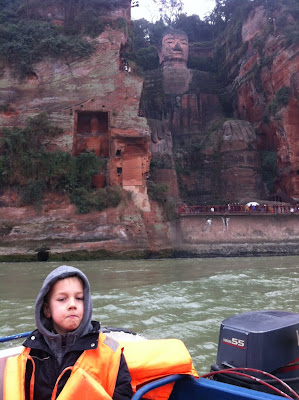 On a recent pollution day, I went on a field trip with Simon's class to the National Aquatics Center, better known as the "Water Cube." In 2008 the cube was the site of the Olympic swimming competition in Beijing.
On a recent pollution day, I went on a field trip with Simon's class to the National Aquatics Center, better known as the "Water Cube." In 2008 the cube was the site of the Olympic swimming competition in Beijing.I had seen the Cube already a million times from the outside, but had never gone in.
Turns out, it is a pretty awesome structure. The outside of the building contains no less than 3100 "pillows," which are those irregular, puffy things that are morphed together to form the cube.
The pillows are made of a plastic called ethylene tetrafluoroethylene, which apparently even at 0.2 mm of thickness (1/125th of an inch, for you Americans) is sturdy enough to not break and keep in heat. Apparently you can drive a car over these plastic pillows (sadly we did not get to try) without them breaking. The ETFE also lets in more light and heat than regular glass, which reduces energy consumption. I might consider cladding my own home in ETFE pillows!

Technically, the building is not a cube, but a "rectangular box" (a cuboid), but I think only Wikipedia dares to point out the difference.

Where the swimmers went next.

The Olympic Pool. Site of 65 new Olympic swimming records and 25 world swimming records.

The diving area. I considered a plunge.

Simon (in red jacket) and his class mates listening to a presentation about the pool.

The roof. I checked, and no bubbles are the same.

Checking the strength of the pillows. Sadly we did not bring our car to drive over it.

The cube when it was under construction.

I get dizzy looking at it :-)

The viewing terrace to view the Olympic records of the recreational swimmers.

The beach master himself.

The Beijing National Stadium, or Bird's Nest, is just across the street. The Water Cube and Birds Nest together reflect ancient Chinese architecture, with the circular Nest representing heaven and the square Cube representing earth.
In het Nederlands: Vorige week was ik met Simon's class op bezoek bij het Olympisch zwembad, de "Water Cube." Het gebouw heeft een mooie architectuur. De bubbels die je ziet zijn allemaal plastic kussentjes, bijeengehouden in een stalen frame. De Water Cube staat dichtbij het andere beroemde Olympische stadion, de "Bird's Nest."
















